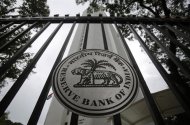RBI surprises with rate hike; trims rupee support steps
By Tony Munroe and Suvashree Dey Choudhury
MUMBAI (Reuters) - Reserve Bank of India Governor Raghuram Rajan surprised markets in his maiden policy review on Friday by raising interest rates to ward off rising inflation, while scaling back some of the emergency measures put in place to support the ailing rupee.Rajan, who took office early this month amid India's worst economic crisis since 1991, increased the RBI's policy repo rate by 25 basis points (bps) to 7.50 percent, defying widespread forecasts that he would leave the rate on hold to bolster a sluggish economy.
As expected, the former IMF chief economist struck a hawkish tone but was non-committal about the direction of the next policy rate move and said he intends to withdraw liquidity tightening steps that had been implemented to stabilise the currency as soon as market conditions allow.
Despite an economy that grew at just 4.4 percent in the June quarter, its weakest in four years, Rajan opted to increase India's policy interest rate for the first time in nearly two years, following similar moves by Indonesia and Brazil whose currencies have also been hit by heavy capital outflows in recent months.
India's wholesale price index (WPI) inflation rose to a six-month high of 6.1 percent in August, with consumer price inflation (CPI) at 9.52 percent.
"In the absence of an appropriate policy response, WPI inflation will be higher than initially projected over the rest of the year," Rajan, 50, said in his policy statement.
"What is equally worrisome is that inflation at the retail level, measured by the CPI, has been high for a number of years, entrenching inflation expectations at elevated levels and eroding consumer and business confidence," he said.
While Indian growth rates are less sensitive to interest rate changes than some other countries, Indian voters are very sensitive to inflation, and there are several important state elections over coming months and a general election due by May.
Government bonds, the rupee and stocks all extended losses after the RBI decision.
The rupee fell as much as 20 percent this year to a record low in late August as investors pulled money from emerging markets ahead of an expected move by the U.S. Federal Reserve to begin scaling back its massive stimulus programme. It has recovered some of those losses since Rajan took over at the RBI amid high expectations on September 4, gaining about 9 percent through Thursday, helped by the Fed's unexpected decision this week to hold off on tapering its bond purchases.
"The statement clearly has a strong hawkish bias as it states that with a relatively more stable exchange rate, monetary policy formulation will be determined once again by internal determinants viz inflation and fiscal deficit," said Anubhuti Sahay, economist at Standard Chartered in Mumbai.
Full coverage of the RBI review http://in.reuters.com/subjects/rbi-policy-review
India rates, inflation & industrial output http://link.reuters.com/deq95s
ROLLING BACK RUPEE SUPPORT
The Fed's surprise move to forge ahead with its current easy money policy gave Rajan an extra cushion to roll back some of the steps imposed to bolster a currency that had been the worst performer in Asia, dragged down by investor worries over the country's record current account deficit.
Rajan, who famously forecast the global financial crisis, said on Friday that domestic drivers of the rupee now take precedence: "The focus has turned to internal determinants of the value of the rupee, primarily the fiscal deficit and domestic inflation.
The RBI on Friday reduced the marginal standing facility (MSF) rate by 75 bps to 9.50 percent, which makes borrowing cheaper for banks. It had raised the MSF rate to 10.25 percent in mid-July to tighten market liquidity and bolster the rupee, and the MSF had been widely regarded as the effective policy rate.
Rajan said he wanted the repo rate to resume its place as the operational policy rate as the rupee support measures are unwound, returning the gap between the repo rate and the MSF rate to its customary 100 basis points.
"It could be that we walk (move) more on the MSF side, but it could be that the repo rate will do some of the walking. I want to be at this point entirely neutral on what the next step would be. It would be dependent on economic conditions," he told a media briefing.
Also on Friday, the RBI partially scaled back the minimum cash balance requirement that banks must keep with the central bank on a daily basis

No comments:
Post a Comment